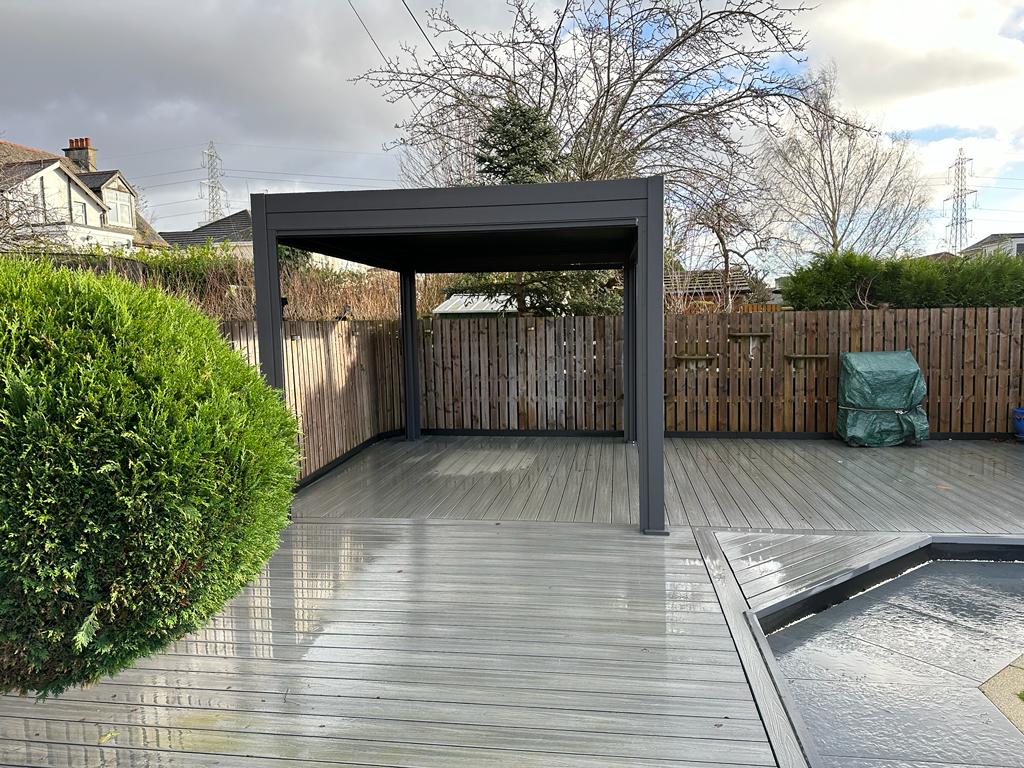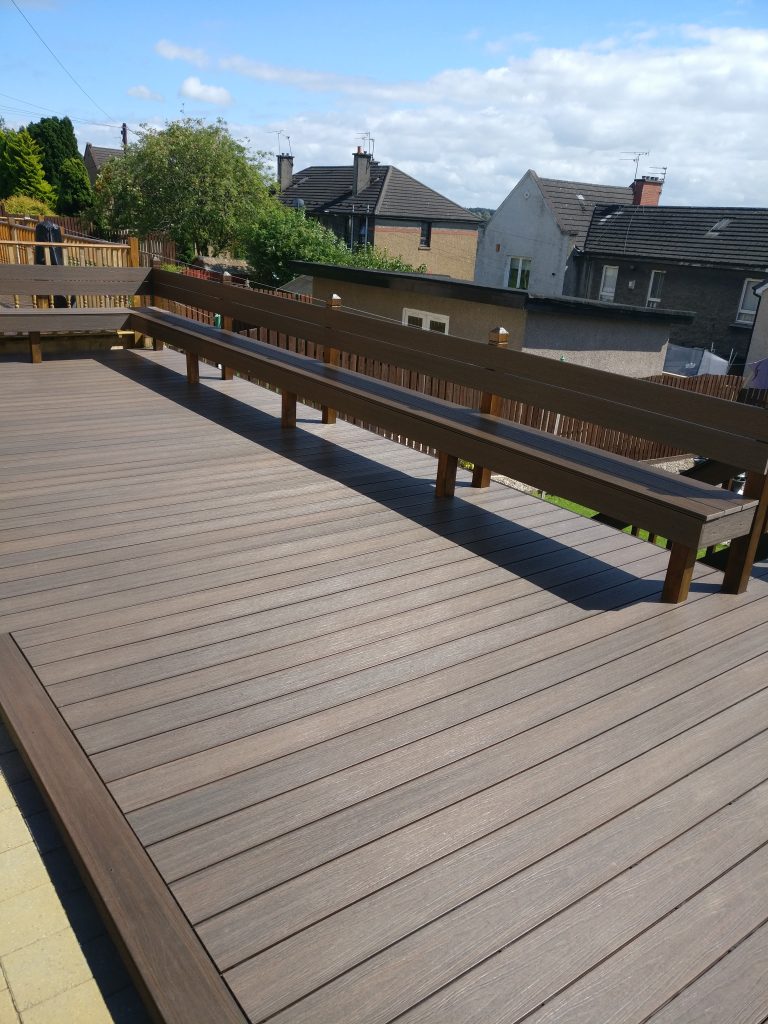Composite decking has become a popular choice for outdoor spaces due to its durability, low maintenance, and aesthetic appeal. Over time, it can accumulate dirt, stains, and grime, detracting from its visual appeal. This is where jet washing comes into play.
In this article, we will explore the concept of jet washing, its benefits for composite decking, as well as the potential risks involved. We will delve into the proper techniques for safely jet washing composite decking and discuss situations where it may be best to avoid this method. By the end of this article, you will have a comprehensive understanding of when and how to effectively jet wash your composite decking, ensuring its longevity and pristine appearance.

Composite decking is a type of decking made from a combination of wood fibres, plastics, and other materials, designed to mimic the look and feel of traditional wooden decking while offering increased durability and resistance to rot, decay, and insect damage.
Composite decking, also known as wood polymer composite, is a durable and weather-resistant alternative to traditional wood decking materials, offering enhanced longevity and minimal maintenance requirements.
It is composed of a mixture of wood fibres, plastic, and binding agents, resulting in a material that is resistant to rot, warping, and insect damage. Unlike traditional wood, composite decking does not require staining, sealing, or painting, making it a low-maintenance option for outdoor spaces.
Its durability and weather-resistant properties make it ideal for withstanding harsh environmental conditions, including intense sunlight, heavy rainfall, and fluctuating temperatures, without fading or deteriorating. These features make composite decking a popular choice for homeowners seeking a long-lasting and visually appealing outdoor flooring solution.
What is jet washing?
Jet washing, also referred to as pressure washing or power washing, is a cleaning and maintenance technique that utilises high-pressure water to remove dirt, debris, and stains from various surfaces.
This method is widely used for cleaning exterior surfaces, such as driveways, patios, fences, and cladding, as well as commercial spaces like car parks and building exteriors.
The equipment used in jet washing typically includes a high-pressure hose, a nozzle, and a machine that generates the pressurised water. The effectiveness of jet washing lies in its ability to penetrate and dislodge stubborn dirt and grime, making it an efficient solution for maintaining cleanliness and preserving the aesthetics of outdoor areas.

What are the benefits of jet washing composite decking?
Jet washing composite decking offers several benefits, including effective cleaning of the surface, removal of mould, mildew, and algae, without the need for extensive scrubbing.
This cleaning method can reach deep into the grooves and crevices of the decking, ensuring a thorough removal of dirt and grime. The powerful pressure of jet washing can help in revitalising the appearance of the composite decking, enhancing its visual appeal. The anti-microbial properties of this cleaning technique also contribute to maintaining a hygienic outdoor environment, making it an ideal solution for preserving the beauty and longevity of your decking.
Removes Dirt and Stains
Jet washing effectively removes accumulated dirt and stubborn stains from composite decking, restoring its appearance and enhancing its aesthetic appeal.
The high-pressure water stream used in jet washing provides a thorough and efficient cleaning process, penetrating deep into the surface to dislodge and eliminate embedded grime. This method not only improves the visual appeal of the decking but also helps maintain its structural integrity.
The transformation is visually striking, as the once weathered and soiled decking emerges looking rejuvenated and pristine. Jet washing also offers a sustainable solution by reducing the need for harsh chemical cleaners, making it an environmentally friendly choice for outdoor surface maintenance.
Restores Colour and Shine
Jet washing contributes to the restoration of the original colour and shine of composite decking, revitalising its visual appeal and aesthetic quality.
This method of cleaning effectively removes built-up dirt, grime, and mildew, revealing the true vibrancy of the decking’s colour and restoring its original shine. By eliminating these impurities, the composite decking regains its lustre, making it look newer and well-maintained. Jet washing prevents discolouration and prolongs the lifespan of the decking, ultimately reducing the need for frequent replacements and costly repairs.
The process also enhances safety by removing slippery residues, making the decking safer for use, especially in damp or wet conditions.
Prevents Mold and Mildew Growth
Jet washing effectively prevents the growth of mould, mildew, and algae on composite decking, maintaining a clean and hygienic outdoor surface.
This method not only enhances the aesthetic appeal of the outdoor area but also contributes to the overall longevity of the composite decking. By removing built-up dirt, grime, and organic matter, jet washing helps prevent deterioration of the decking material. It minimises the risk of slips and falls caused by slippery surfaces. Regular jet washing upkeep can significantly reduce the need for costly repairs and prolong the lifespan of the outdoor space, making it a valuable preventive maintenance practice.
Increases the lifespan of the decking
Regular jet washing can extend the lifespan of composite decking by maintaining its cleanliness, structural integrity, and overall longevity.
This cleaning method effectively removes dirt, grime, and moss that can accumulate on the surface, preventing deterioration and preserving the structural condition of the composite materials. By eliminating debris and reducing the risk of moisture retention, jet washing helps prevent issues such as rot, mould, and decay, ultimately contributing to the longevity of the decking.
Regular maintenance through jet washing also ensures that the composite decking retains its aesthetic appeal and structural strength, offering an excellent return on investment in terms of durability and visual appeal.
What are the risks of jet washing composite decking?
Whilst jet washing offers effective cleaning, there are potential risks such as damage to the decking material and the inadvertent use of harsh cleaning solutions that may compromise its integrity.
It’s important to exercise caution and use appropriate cleaning solutions when jet washing to avoid damaging the surface. High-pressure jet washing can lead to etching or splintering of the decking material if not used carefully. The use of harsh chemicals can weaken the structure and colour of the deck. It’s crucial to follow manufacturer recommendations and seek professional advice when unsure. By choosing the right equipment and solutions, the risks associated with jet washing can be minimised, ensuring a thorough yet safe cleaning process for your decking.
Damage to Decking Material
Excessive water pressure during jet washing can lead to damage to the composite decking material, compromising its structural integrity and aesthetic quality.
It’s important to be mindful of the recommended pressure levels and techniques when cleaning composite decking to avoid causing irreversible harm. High-pressure water streams can cause warping, splintering, or even breakage of the decking boards. Excessive pressure may also strip away the protective coatings, making the material more vulnerable to moisture and mold. Therefore, using appropriate pressure levels and maintaining a safe distance during cleaning are essential for preserving the longevity and visual appeal of the decking.
Injury to Person Performing Jet Washing
The use of jet washing equipment without proper safety precautions may pose the risk of injury to the person performing the cleaning, highlighting the importance of using protective gear and safety measures.
It is essential for individuals operating jet washing equipment to wear appropriate personal protective equipment (PPE) such as goggles, gloves, and non-slip footwear to safeguard themselves from potential hazards. In addition to this, adhering to safety protocols and guidelines, including conducting regular equipment checks, maintaining a safe distance from electrical sources, and using the equipment in well-ventilated areas, plays a crucial role in minimising the risk of accidents and injuries.
How to Clean Composite Decking with a Pressure Washer Safely?
Jet washing composite decking safely involves utilising appropriate water pressure, maintaining a safe distance, and applying protective coatings to minimise potential damage and maximise cleaning effectiveness.
Water pressure control is crucial, as using excessively high pressure can cause damage to the composite surface. It’s recommended to use a pressure of around 1000-1500 psi. Keeping a safe distance of 12-18 inches from the surface helps to avoid any accidental gouging or etching.
Applying a protective coating after cleaning can further safeguard the decking from mould, mildew, and UV damage, ensuring its longevity and pristine appearance.
Use the correct pressure and nozzle
Selecting the appropriate pressure and nozzle for jet washing is crucial to prevent damage to the composite decking surface while ensuring effective cleaning and stain removal.
This balance is achieved by understanding the specific requirements of the material being cleaned and the type of contaminants to be removed. Using high pressure and an unsuitable nozzle can lead to etching, surface gouging, or even water penetration, whereas low pressure may not be effective in removing tough stains. By matching the pressure and nozzle correctly, you can maintain the integrity of the composite decking while achieving optimal cleaning results.
It’s essential to consider the manufacturer’s guidelines and recommendations to protect the surface and prolong its lifespan.
Keep a Safe Distance
Maintaining a safe distance during jet washing is essential to prevent potential damage to the decking material while ensuring thorough and effective cleaning of the surface.
The pressure exerted by jet washing equipment can be powerful, and standing too close to the surface being cleaned may result in etching or gouging. It is important to consider the equipment specifications and adjust the distance accordingly. Maintaining a safe distance also minimises the risk of injury from any debris or chemical runoff.
By adhering to safety protocols and using the appropriate equipment, the cleaning process can be executed effectively without compromising the integrity of the surface.
Use Protective Gear
Utilising appropriate protective gear such as goggles, gloves, and protective clothing is crucial to ensure the safety of the individual performing jet washing on composite decking.
This protective gear serves as a barrier against hazardous chemicals, high-pressure water, and potential debris. Goggles shield the eyes from splashes and chemicals, whilst gloves protect the hands from abrasions and chemical exposure. Wearing protective clothing safeguards the skin from direct contact with harmful substances.
Ensuring the proper fit and quality of these protective gears is equally important to maximise their effectiveness. Neglecting to use these safety measures can result in serious injuries, emphasising the paramount importance of prioritising personal safety when undertaking jet washing tasks.
When is it best to avoid using a jet washer on composite decking?
It is advisable to avoid jet washing composite decking if the material is old or damaged, if the individual is not comfortable performing the cleaning, or if they lack the proper equipment for the task.
In cases where the decking is showing signs of wear and tear, such as cracking or warping, using a gentler cleaning method may be more suitable. If the person undertaking the cleaning is not experienced or confident in using a jet washer, it is important to reassess the cleaning approach to ensure safety and effective results.
If the necessary protective gear and cleaning solutions are not readily available, it may be best to postpone the jet washing until the suitable equipment and materials can be acquired.
If Decking Is Old or Damaged
When composite decking is old or damaged, alternative maintenance approaches should be considered, as jet washing may exacerbate existing issues and compromise the integrity of the material.
This is particularly important because older or damaged decking may have weakened areas that could be further damaged by the force of jet washing. In such cases, alternative maintenance strategies, such as gentle hand cleaning or using specialised cleaning solutions, can be more appropriate.
It’s important to have a regular maintenance schedule in place to address any damage or ageing of the decking to ensure its longevity and structural integrity.
If you do not feel comfortable using a high-pressure water jet for cleaning
If an individual is not comfortable with performing jet washing on composite decking, it is advisable to explore alternative maintenance methods or seek professional assistance to ensure safety and effective upkeep.
Taking the individual’s comfort and safety into consideration is crucial when maintaining composite decking. Alternatives such as gentle scrubbing with a soft-bristle brush or using a specialised cleaning solution can offer effective upkeep without the need for high-pressure washing.
Involving professionals in decking maintenance can provide a thorough and expert approach, ensuring the longevity and pristine appearance of the decking while prioritising safety.
If You Do Not Have the Proper Equipment
Lack of proper equipment for jet washing may pose risks to both the individual and the decking material, making it essential to explore alternative maintenance options or acquire suitable equipment for the task.
Without the appropriate equipment, jet washing can lead to potential damage and accidents, such as splinters or slipping on wet surfaces. The right tools, like a high-pressure washer with the correct settings, can ensure efficient cleaning without harming the decking. Safety goggles, gloves, and sturdy footwear are crucial to protect the operator during the process.
Opting for alternative maintenance methods, such as manual scrubbing or gentle chemical cleaning, can also maintain the decking without the need for specialised equipment, offering a safer approach while still achieving effective upkeep.








